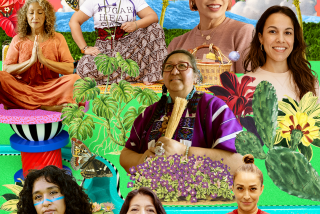Taiwanese Master Cleaves to Therapy on a Sharp Edge
- Share via
TAIPEI, Taiwan — George Pan grabs a heavy meat cleaver from the rack, sharpens it on a whetstone block and rubs iodine over the blade while an ailing patient waits to begin his unique therapy.
Pan taps the patient’s body with the sharp--not flat--side of a 10-inch blade, saying his “knife massage” releases the body’s stored energy, increases blood flow and washes away harmful toxins.
“I don’t push or pull when I set the meat cleaver down so I don’t harm the patients,” Pan said, shaving off hair from his forearm with the knife to test its sharpness.
Like many practitioners of traditional Chinese medicine, Pan believes the human body is crisscrossed with streams of energy called “qi” that originate at the abdomen. Tapping these vital points could help the body heal itself, Pan says.
Pain and sickness are caused when energy points throughout the body are blocked, and Pan believes the stainless steel cleavers work better than acupuncture needles to release and transmit the energy.
“Static energy is released with the up and down movement of the knife. We call it self-cure,” Pan says, hitting a patient’s chest with light up-and-down strokes in much the same way he would dice an onion.
Pan never strikes heavily enough to break the skin and cause bleeding. But one patient twitches and squints as Pan thumps the sharp end of his polished cleaver inches from the upper groin to treat what he says is a bruised liver.
“You hear that sound like a drum?” Pan asks, striking heavily enough to leave red streaks on the skin. “Too much drinking. Chop, chop, chop and the pain will go away.”
Most patients visit Pan’s Dao Liao, or Knife Therapy Assn., for common aches and pains. They lie on massage beds while Pan applies light chopping motions with the cleaver’s blade on traditional pressure points that correspond to ailing body parts.
Pan’s patients are generally calm during the half-hour session, which costs $15 in American currency. Some giggle when Pan tickles their armpits with the blade’s sharp corners. Others groan in relief as he chops the tense upper shoulders.
“Don’t be afraid. This will cure your inner organs,” Pan reassures a nervous new patient as he rubs his thumb over the knife’s blade.
Doctors had scheduled Li Su-yu, an 81-year-old retired air force pilot, for a kidney dialysis. Instead, Li opted for Pan’s more esoteric cure and says his uric acid has since dropped, irregular urinary patterns have improved and pain in both legs is gone.
“It’s been three months since I started, and I feel a lot healthier now,” Li says, his entire back covered in strips of red.
Pan claims his therapy can help cure any sickness, even cancer. Releasing the patient’s latent energies through regular knife massage on vital energy points can ease the adverse effects of chemotherapy such as hair loss and nausea, Pan says.
Lin Yu-hua, a 48-year-old office worker, began Pan’s therapy after doctors removed a breast tumor the size of a large pearl in August. The pain in her upper chest was so bad that she couldn’t raise her arms, Lin said.
“But now my doctors call it a 100% recovery,” Lin said. “My complexion remains the same and I’ve managed to keep my hair from falling out.”
A microbiologist and soil toxicologist by training, Pan says his cleaver cure was a common form of self-medication in China more than 2,000 years ago. The technique was preserved through the ages by Buddhist monks who used it as a form of meditation and therapy.
When Chinese monks brought Buddhism to Japan more than 1,000 years ago, they brought with them the technique, which became popular with samurai warriors. The monks used long, razor-sharp swords, says Tsai Huo-cheng, a Taipei-based Chinese medical specialist.
The therapy focuses on easing blood flow through the lymph nodes, and the sword’s steel conducts energy through the body’s energy points, said Tsai, himself a practitioner of acupuncture and acupressure massage treatment.
Most physicians practicing Western medicine, however, say there’s no scientific evidence of “qi,” and they don’t recommend that patients rely solely on traditional Chinese cures such as knife massage.
A devout Buddhist, Pan studied 20 years ago with a Japan-based Buddhist monk who insisted on the use of samurai swords for greater effectiveness. After failing to find a sword with the right weight, Pan had cleavers made to his specifications.
“Heavy knives are used for more serious illnesses. Hitting can be painful at first, but then the sickness heals and gets better,” Pan said.
Lightly tapping the corner of his cleaver from a student’s hairline down to the eyelid, Pan asks a patient, “You have a headache? Here, let me hit your head.”
More to Read
Sign up for Essential California
The most important California stories and recommendations in your inbox every morning.
You may occasionally receive promotional content from the Los Angeles Times.










